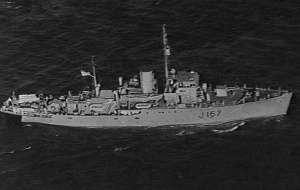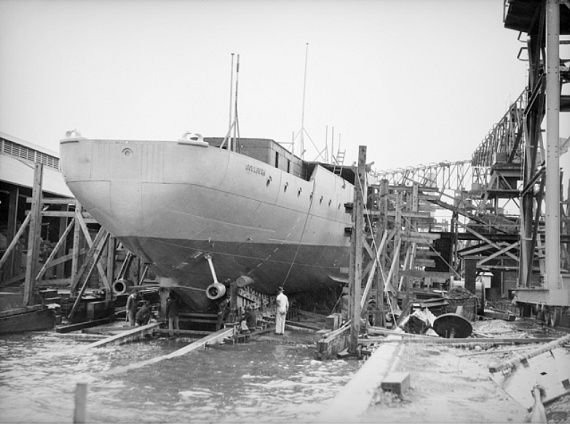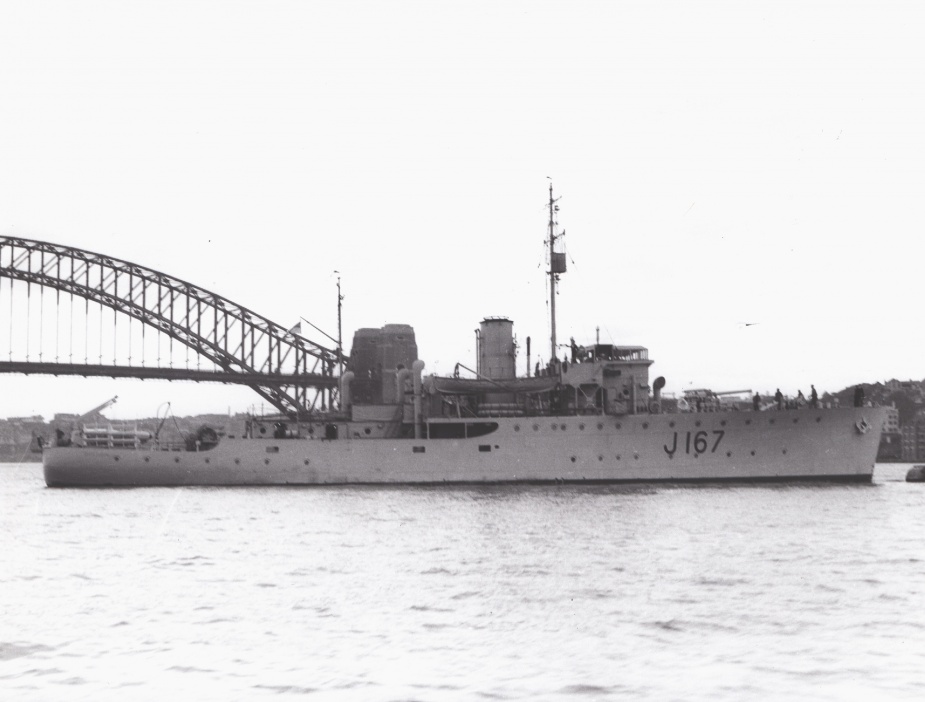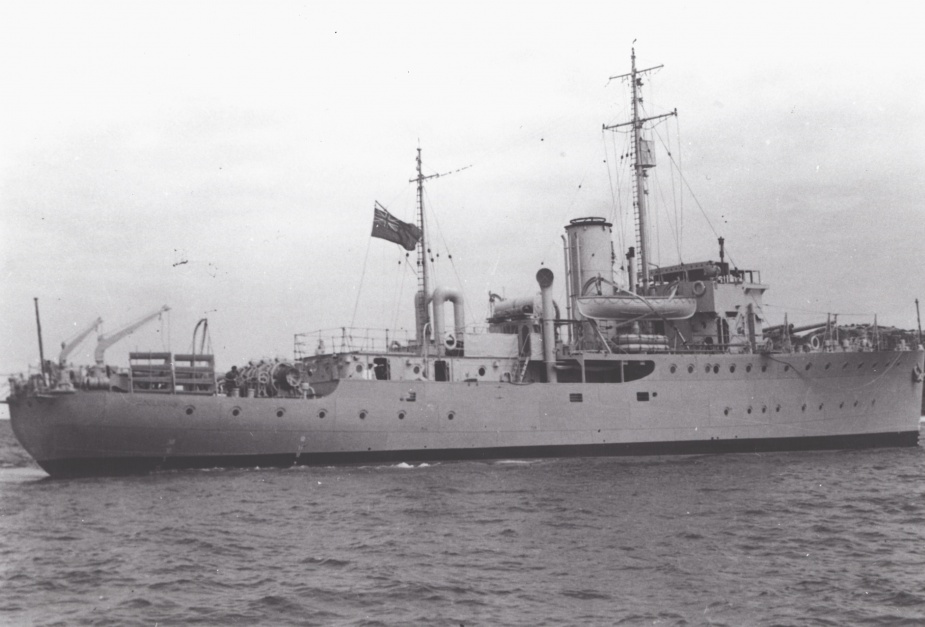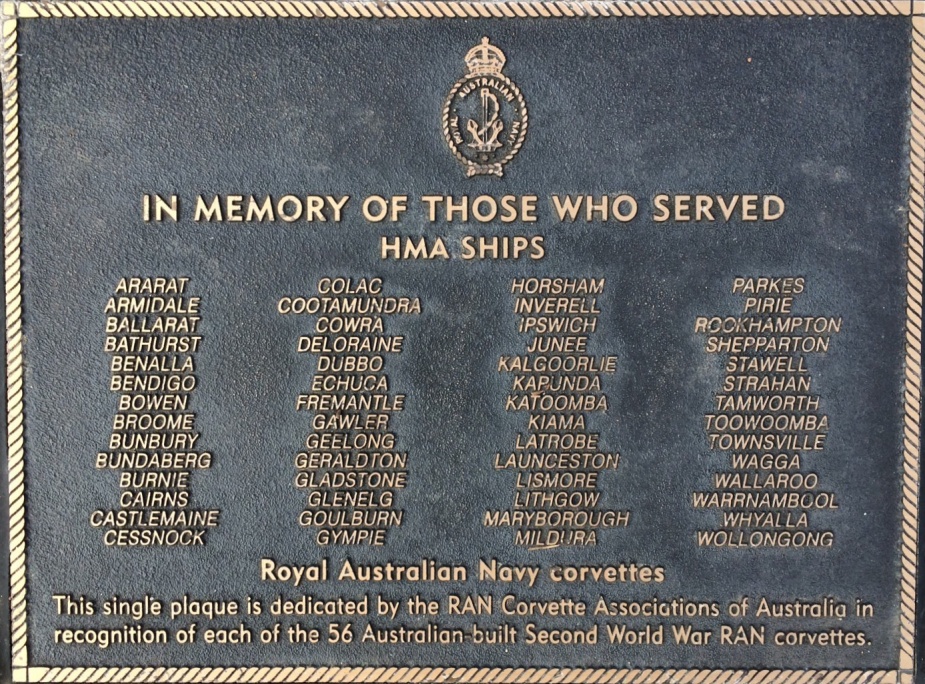HMAS Goulburn
| Class |
Bathurst Class |
|---|---|
| Type |
Australian Minesweeper |
| Pennant |
J167, B243, A117 |
| Builder |
Cockatoo Docks and Engineering Co Ltd, Sydney |
| Laid Down |
10 July 1940 |
| Launched |
16 November 1940 |
| Launched by |
Mrs Crace, wife of Rear Admiral Commanding Australian Squadron |
| Commissioned |
28 February 1941 |
| Decommissioned |
27 September 1946 |
| Dimensions & Displacement | |
| Displacement | 743 tons |
| Length | 186 feet |
| Beam | 31 feet 2 inches |
| Draught | 8 feet 6 inches |
| Performance | |
| Speed | 15 knots |
| Complement | |
| Crew | 85 |
| Propulsion | |
| Machinery | Triple expansion, 2 shafts |
| Horsepower | 1750 |
| Armament | |
| Guns | 1 x 4-inch gun |
| Awards | |
| Battle Honours | |

HMAS Goulburn was one of sixty Australian Minesweepers (commonly known as corvettes) built during World War II in Australian shipyards as part of the Commonwealth Government's wartime shipbuilding programme. Twenty (including Goulburn) were built on Admiralty order but manned and commissioned by the Royal Australian Navy. Thirty six were built for the Royal Australian Navy and four for the Royal Indian Navy.
HMAS Goulburn was laid down at Cockatoo Docks and Engineering Co Ltd, Sydney, NSW on 10 July 1940. She was launched on 16 November 1940 by Mrs Crace, wife of Rear Admiral Commanding Australian Squadron, and was the first RAN warship to carry the name of the regional city in the Southern Tablelands in NSW.
Goulburn commissioned at Sydney on 28 February 1941 under the command of Lieutenant Basil Paul RANR(S).
Following a period of working up exercises in the waters off New South Wales, Goulburn joined the 20th Minesweeping Flotilla in Bass Strait on 23 April 1941. She operated as a sweeper with the Flotilla until 31 May 1941 and was engaged in clearing sweeps in Bass Strait and off the New South Wales coast, where minefields had been laid by the German auxiliary cruiser Penguin and her auxiliary minelayer Passat. Goulburn swept one mine.
On 16 June 1941 Goulburn, in company with her sister ship HMAS Burnie (I), sailed from Sydney for Singapore where both ships became attached to the China Station. At Singapore in November 1941, with HMA ships Bendigo, Burnie (I) and Maryborough, she formed the 21st Minesweeping Flotilla.
Following the outbreak of the Pacific War in December 1941, Goulburn was engaged on escort, patrol and minesweeping duties, from Singapore down to Sunda Strait, until the end of January 1942.
Arriving at Batavia on 30 January, Goulburn remained in the harbour until 5 February when she proceeded on an anti-submarine patrol of Batavia Roads, a duty she maintained until 8 February. On this day Goulburn proceeded with Burnie (I) to escort two merchant ships bound for Colombo. The crew of one of these, the SS Kumsang, refused to sail. The Commodore Commanding China Force therefore ordered the movement to be made escorting the remaining ship, the SS Harpasa. At 12:00 the following day Goulburn and Burnie parted company from the Harpasa in position 8°26´S, 101°31´E, in the Indian Ocean, and returned through Sunda Strait.
On 12 February Goulburn arrived at Oosthaven in Sumatra and remained outside the anchorage as the anti-submarine screen for the next few days. On 17 February she stood by during demolition operations at Oosthaven before parting company from Burnie (I) and proceeding to Ratai Bay to escort the Dutch ships Both, Stage, Marilyse Moller and Balikpapan. Goulburn and convoy, plus the SS Van Outhoorn, steamed south into the Indian Ocean unmolested. At 19:40 on 18 February the convoy was ordered to disperse and proceed independently. Goulburn set course for Tjilitjap where she arrived during the afternoon of 19 February. She remained at Tjilitjap during 20 and 21 February and left for Batavia the following day.
Passing through Sunda Strait on 23 February, Goulburn reached Batavia without incident the following morning. On the afternoon of 24 February she sailed with HMAS Toowoomba to carry out sweeps at the entrance to Sunda Strait. This operation was completed after some delay due to the presence of shadowing enemy aircraft. Returning to Batavia on 25 February, Goulburn remained in the harbour until 27 February, when she left to join the 21st Minesweeping Flotilla on the Sunda Strait patrol. She passed HMAS Hobart en route in company with other cruisers and observed the formation being attacked by Japanese dive bombers. Goulburn rejoined the flotilla off Merak. Shortly afterwards attacks developed from dive bombers operating in three waves of three planes at twenty minute intervals. No damage resulted.
On 28 February the Sunda Strait patrol was discontinued and the whole flotilla moved towards Tjilitjap. Arriving the following morning, Goulburn left almost immediately for Australia. Except for being sighted and shadowed by a Japanese bomber, she saw no sign of the enemy. Goulburn reached Fremantle during the afternoon of 9 March with only seven tons of fuel to spare.
On her return to Australia Goulburn was assigned to convoy escort duty on the east Australian coast, mainly between Brisbane and Gladstone. In March 1944, following a long refit which kept her in dockyard hands for almost three months, she proceeded to New Guinea waters where she was engaged on escort and patrol duties.
In June 1944 Goulburn assisted the landings at Dugumu Bay and on Sogari Island in New Guinea. Between July and September 1944 she was engaged on general escort duty in New Guinea waters, broken by a brief visit to Cairns for docking.
On 25 September 1944 she embarked eight native scouts and one United States Army intelligence officer (Major Ames) at Bosnik and proceeded to the Mapia Islands where the native scouts were disembarked at a position to the southward of Bras Island. The primary object of this operation was to endeavour to find out the strength and disposition of the Japanese remaining in the Mapia Island group.
Plans had previously been made to re-embark the native scouts two days later, and on 29 September Goulburn arrived at the arranged rendezvous off Finaldo Island. A close inshore search was carried out for the native scouts but they were not sighted and the search was continued to Bras and Pegun Islands. These islands were circled twice and as there was still no sign of the scouts, Major Ames decided to land on Bras Island and carry out a reconnaissance.
Together with an armed party of six ratings from the crew of Goulburn, Major Ames made a landing using the ship's whaler. Prior to the landing the entire area was shelled and strafed by Goulburn. The landing party returned to the ship about an hour later, without having contacted any natives or Japanese, although there were signs that the area had recently been occupied. Goulburn then set a course for Pegun Island but on arrival the sea and weather conditions were very unfavourable and it was impossible to make a further landing on this island. A village on Pegun Island, which was thought to contain Japanese, was shelled before Goulburn left the area and proceeded to Biak.
No fire was returned from the shore during any part of this operation, nor were any Japanese seen, and as the native scouts did not return it was thought that they had been captured. This was confirmed a few days later when American PT Boats attempted to land an armed party on Pegun Island and encountered considerable opposition from the Japanese garrison.
On another occasion Goulburn embarked a number of Netherlands Indies Civilian Administration officers and officers from the Allied Intelligence Bureau at Noemfoor, and sailed for Little Geelvink Bay to endeavour to picked up a Netherlands Army officer and native scouts who had been carrying out reconnaissance of the Japanese internment camps in the vicinity of the Praft River for a week or more. The vessel arrived at the rendezvous position near Warikau on 3 October and carried out a close inshore patrol in Little Geelvink Bay. As no contact was obtained with the patrol a course was set for Mois Aoeri Island, situated about nine miles north of Manokwari, in the hope of picking up the NICA scouts there.
When the ship arrived off Mois Aoeri a party of Goulburn ratings and NICA officers made a landing on the island, once again using the ship's whaler. After traversing a section of the island a contact was made with the native scouts and just as the whaler commenced to return to Goulburn, a party of three Japanese soldiers were sighted endeavouring to make an escape to the mainland in a native canoe. The crew of Goulburn's whaler immediately gave chase and as the Japanese, in the lighter craft, were commencing to gain ground LS Maher, the coxswain of the whaler, fired a burst of machine gun fire, wounding one of them in the hand. This was sufficient to convince them that escape was impossible and all three, possibly through fright, fell from their canoe and commenced to swim around, but not towards Goulburn's whaler. The endeavours to persuade the Japanese to enter the whaler were amusing and after coaxing had failed to induce them to swim towards the whaler, two were manhandled into the boat and the other then decided to swim over to it.
While Goulburn was cruising off the island, waiting to recover the whaler, large numbers of Japanese were observed on the mainland. The NICA scouts who had just been recovered from Mois Aoeri reported that there were about 200 Japanese in this camp and the Japanese prisoners were then made to point out the key position in the camp. The area was then shelled and strafed by Goulburn. On completion of the bombardment Goulburn proceeded to Noemfoor.
From Noemfoor she proceeded to B-Van Seroei Harbour, Japen Island, where she arrived on 4 October 1944, and after a short stay in the harbour proceeded to Jamakaan on Rioemberpon Island to pick up 150 Javanese soldiers who had escaped from Japanese labour gangs and concentration camps in the Manokwari area. Despite the fact that there were estimated to be over 1,000 Japanese on the mainland opposite Rioemberpon Island, no opposition was encountered and the embarkation of the Javanese soldiers was without incident.
Following these operations Goulburn was busy until December 1944 escorting convoys between Biak, Morotai and Madang, before returning to Australia.
Goulburn spent the first four months of 1945 in home waters. She returned to New Guinea early in May 1945, where she was engaged in anti-submarine and sweeping duties at Manus until June. On 14 June 1945 she arrived in Darwin to act as escort to tugs towing a floating dock from Darwin to Milne Bay. This mission completed, Goulburn returned to Manus and from there on 23 July 1945, she proceeded for Eniwetok in the Marshall Islands to act as part escort of a convoy to Manus.
On 15 August 1945 Goulburn was at Manus. On 30 August she sailed for Hong Kong in company of her sister ships Bendigo and Whyalla, forming escort to a seven ship slow convoy. Proceeding via Morotai and the Philippines, they reached Hong Kong on 21 September. Goulburn then joined the 21st Minesweeping Flotilla for sweeps in Chinese waters. These operations were completed early in November and on 16 November the flotilla, consisting of HMA ships Ballarat, Bathurst, Burnie, Maryborough, Cairns, Fremantle, Bendigo, Toowoomba and Goulburn, proceeded for Australia. Goulburn arrived in Sydney in December 1945, bringing her naval seagoing career to a close, having steamed some 165,000 miles.
Goulburn paid off on 27 September 1946 and was sold as a seagoing vessel to Captain SP Bell, of Pacific Enterprise Incorporated, for £12,500 on 13 October 1947. She was later resold to PJ Lobo & Co, Hong Kong, for £15,000, and again to AH Carrol, acting as agent for Ta Hing Co (Hong Kong) Ltd, in December 1950. However, a Commonwealth Statutory Order issued in January 1951 barred her removal from Australian waters.
Goulburn was resold to John Manners & Co (Aust) Pty Ltd, of Sydney, in 1953 and renamed Benita.
Note: This video is hosted on YouTube. Department of Defence users will not be able to view this video on the Defence Protected Network.
This cine film has been placed online as part of the Sea Power Centre - Australia's ongoing archival digitisation program.
Further reading
- 'The Corvettes: Forgotten Ships of the Royal Australian Navy' by Iris Nesdale - published by the author, October, 1982.
- 'Notable Service to the Empire: Australian Corcettes and the British Pacific Fleet, 1944-45' by Hugh Campbell - published by Naval Historical Society of Australia Inc, 1995.
- 'Corvettes - Little Ships for Big Men' by Frank B Walker - published by Kingfisher Press, NSW, 1996.
- 'The Australian Centenary History of Defence Volume III, The Royal Australian Navy' edited by David Stevens, Oxford University Press, South Melbourne, Victoria, Australia, 2001.

